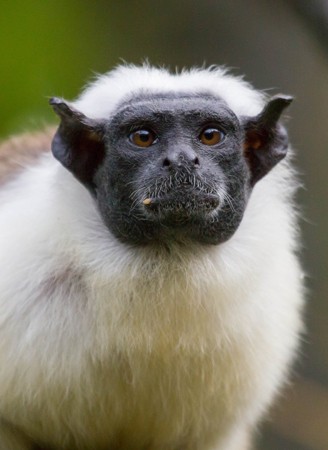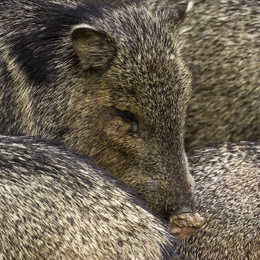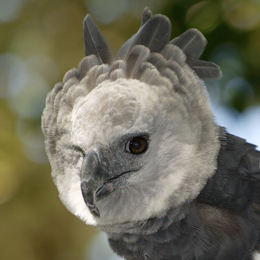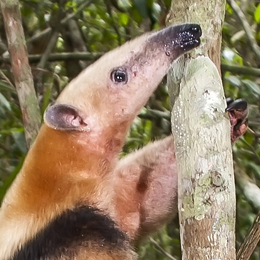Description
The pied tamarin is a monkey species that is also known as the Pied Bare-faced Tamarin or Brazilian Bare-faced Tamarin. These small monkeys have a body length that ranges between 20-28 cm, a tail that measures between 33 and 42 cm and an average weight of 430 grams. They can live up to 19 years. The pied tamarin shows no sexual dimorphism, meaning that both sexes have a similar appearance.
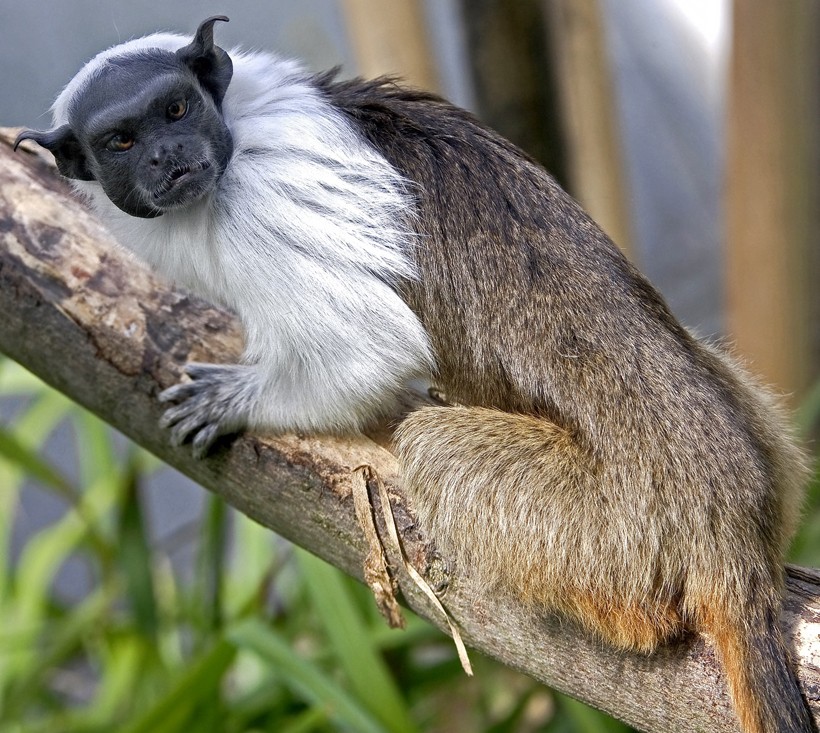
Pied tamarin sitting in a tree
?
Image credits: Mikhail Blajenov/Shutterstock
The pied tamarin possesses well-developed eyes, ears and nose. While males and females may look the same, there's a major difference in vision between the sexes. They both have evolved a primitive level of color vision, but females may enjoy a more efficient trichromatic vision whereas their counterparts are limited to the dichromatic condition. Communication between pied tamarins occurs through either visual, acoustic, olfactory or tactile contact.
Subspecies
There are three known subspecies of the pied tamarin, namely S. b. bicolor, S. b. ochraceus and S. b. martinsi. Habitat and behavior of the three subspecies are similar. The distinguishing factor is the fur color, that exhibit in different intensities of pigmentation.- S. bicolor bicolor
The S. bicolor bicolor has white fur on the anterior half and forelimbs, followed by a pale brown fur on the posterior half of the body as well as their hind limbs.
- S. bicolor martinsi
The anterior half of the body of the S. b. martinsi is similar to the S. bicolor bicolor (white), but this subspecies possesses a black posterior half/hind limbs.
- S. bicolor ochraceous
The S. b. ochraceous is the most distinguishing subspecies and possesses even a variation of color patterns. The entire dorsal portion including anterior and posterior region is brown. A white fur is restricted to the anterior ventral part and the forelimbs.
All three subspecies share the 7500 km2 fragmented forest neighboring Manaus city.
The S. bicolor bicolor has white fur on the anterior half and forelimbs, followed by a pale brown fur on the posterior half of the body as well as their hind limbs.
The anterior half of the body of the S. b. martinsi is similar to the S. bicolor bicolor (white), but this subspecies possesses a black posterior half/hind limbs.
The S. b. ochraceous is the most distinguishing subspecies and possesses even a variation of color patterns. The entire dorsal portion including anterior and posterior region is brown. A white fur is restricted to the anterior ventral part and the forelimbs.
Anatomy and characteristics
The bare-faced tamarins of the Amazon derived their name because of their typical black-colored fur-less face that is followed by a multi-colored fur on the body. The very thick fur is white-colored on their anterior half and forelimbs, while the posterior half, hind legs and tail, is brownish. The posterior color varies among subspecies between brown to black or silver. The black ears are quite large in proportion to the face and the nose appears flat with nostrils that open sideways.
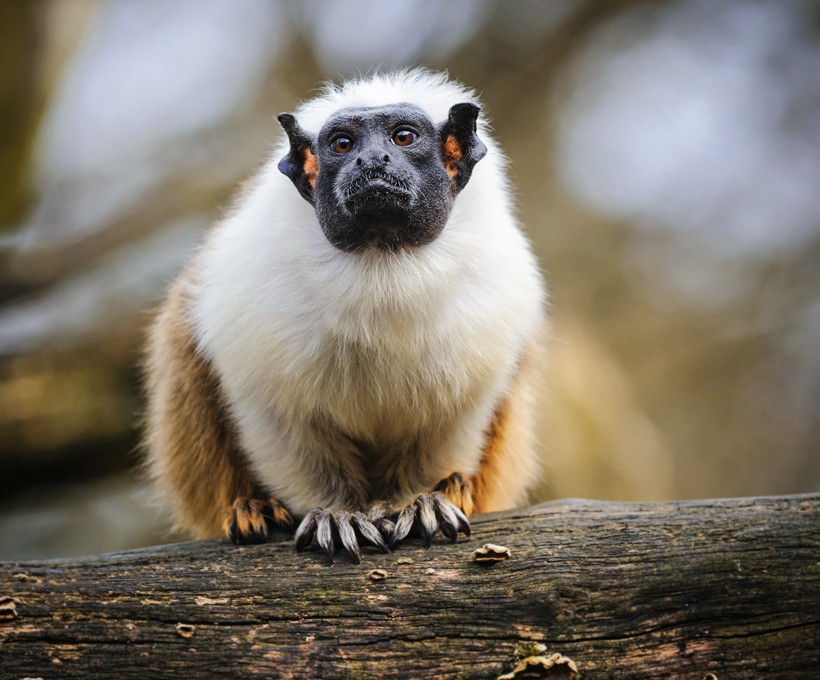
Pied tamarins belong to the new world monkeys, monkeys with a peculiar flat-nose with sideways nostril-openings.
?
Image credits: Natalia Paklina/Shutterstock
The pied tamarin possesses non-opposable thumbs. The nails of the fingers, with the exception of the big toe, are modified into a claw-like structure. They contain 32 teeth, with a dental formula of 2 incisors, 1 canine, 3 premolars and 2 molars on each side of both jaws. The presence of just 2 molar teeth each jaw is noteworthy as related monkeys possess 3 molar teeth. Another distinguishing feature is the size of the canine that is larger than their incisors. The Goeldi's marmoset is the closest related animal that shares the same habitat.
The color vision of pied tamarins is controlled by a single gene on the X chromosome. This gene produces pigments that absorb long and medium wavelength light radiations. Hence, the eyes are able to identify short wavelength colors. Males always exhibit dichromatic vision as well as females that are homozygous for the pigment gene allele. However, females with heterozygous alleles on the gene enjoy trichromatic vision.
Habitat & Diet
The bare-faced pied tamarins are new world monkeys that live in tropical seasonal forests in the Amazon (South America). Their preferred canopy comprises lowland secondary and edge forests, white sand forests and swamps.
The scattered population of S. bicolor has been traced around Manaus with population density ranging between 1.85 to 62.5 individuals per km2. The highest population density has been recorded in the forest of João Boscowhile, the lowest within the war instruction jungle on the outskirts of Manaus city.
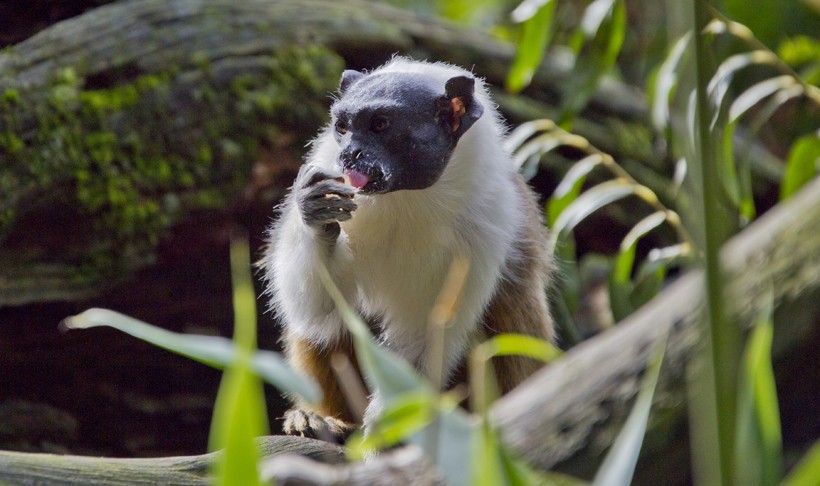
Pied tamarins are omnivorous but prefer a herbivorous diet
?
Image credits: Nippel/Shutterstock
Pied tamarins are diurnal animals and forage actively during the daytime. Walking on four legs, leaping and swinging on vines are their routine practices.
Pied tamarins prefer a herbivorous diet that consists of flowers, leaves, buds, nectar, fruits and secretions from plants. However, they hunt also on insects, spiders, other small arthropods, snails and small vertebrates like frogs and lizards during dry seasons. Hence, they are categorized as omnivorous. Once these monkeys spot a prey, they keep themselves motionless and attack the unsuspecting victim stealthy, killing them by biting or hitting with their palms.
The red-handed tamarin (S.midas) is the biggest competitor regarding their shared habitat, whereby the red-handed tamarin regularly dislodges the pied tamarin.
The pied tamarin is predated by birds, wildcats and humans. They are hunted for food and captured for pet trade. In the vicinity of human habitation, they are also hunted by domestic cats and dogs as well.
Reproduction and Life cycle
Polyandry is the predominant mating system within a group pied tamarins, but polygyny, as well as monogamy, have been observed also within this species. Polyandry is a rare phenomenon in the animal world where the dominant or alpha female of the group alone participates in the sexual act with more than one male, producing offspring annually. The ovulation of other females gets suppressed by the pheromones secreted by the alpha female. As a consequence, they remain sexually inactive.
Breeding with the alpha female occurs during March to May. The female attracts the male through tonguing, an act whereby the female rapidly moves the tongue out of the mouth across the lips. Pied tamarins have a gestation period of about 160 days, after which twins are born in 80% of the pregnancies. The infants weigh 14 to 23% of the body weight of the mother and are born with fur. The infants are incapable of any movement and they don't gain perceptions of their environment. They just cling to their parents for the first 7 weeks of their life.
Carrying of the infants is done by the father predominantly and he transfers the infant to the mother for suckling at intervals of 2 hours. Infants depend solely on breast milk for the first 3 weeks, after which the milk diet is mixed with solid food. After a period of 15-25 weeks, the infants are fully weaned. Other members of the group actively participate in grooming and taking care of the infants, a unique social behavior of tamarins. By the age of 20-21 days, the young ones become more independent but maintaining riding on their parents and caretakers for up to 7 weeks of age.
Females attain puberty by 18 months and males by 24 months. The estrous cycle of the female is around 15 days, whereby menstruation is scanty. The lifespan of pied tamarins in the wild is not clearly understood. However, they live up to 19 years in captivity. Considering the external threats in nature, their average lifetime is estimated a little shorter in the wild.
Behavior, communication & intelligence
Pied tamarins live a social life with a family-like setup. They live in mixed groups comprising up to 15 unrelated individuals. Each group has a reproductively active female (alpha female), that has the monopoly on producing young ones. These mammals are arboreal in habit and keep jumping, cuddling and hoping across the forest canopy, a typical behavior that is similar to monkey species. Pied tamarins are diurnal, omnivorous and forage on varieties of food materials. Major time of the day (~ 60%) is spent for foraging. Foraging is done from ground level to a canopy height of 20 meters, although the preferred height is 10-12 meters. All adults within the group share the responsibility of parenting and the group members sleep huddled together in vines and on branches of trees.
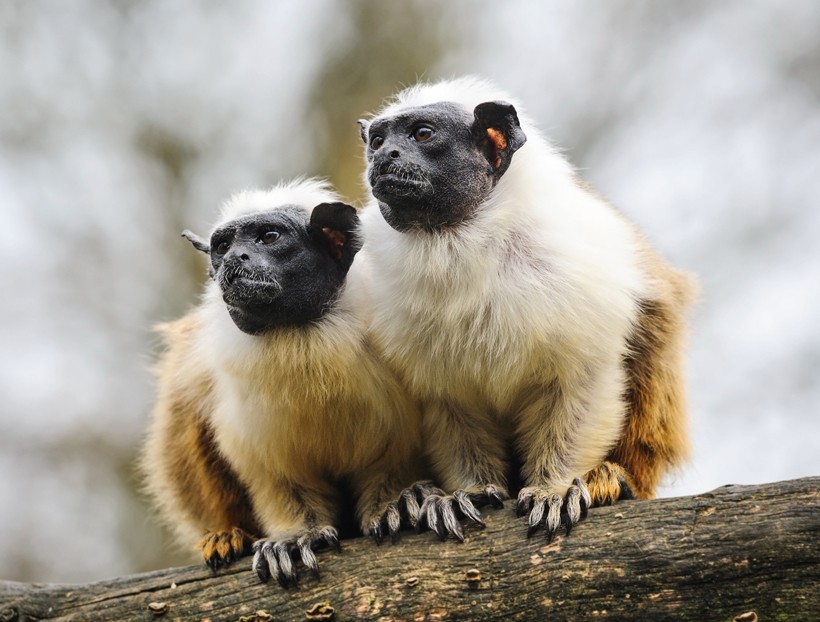
Pied tamarins live in mixed groups comprising up to 15 unrelated individuals.
?
Image credits: Natalia Paklina/Shutterstock
The bare-faced tamarins are a relatively smart monkey species and use diverse ways of communication. Visual communication is marked by body postures and characteristic actions like head-flicking and tonguing. Generally, both gestures are done simultaneously. Head-flicking involves a rapid upward movement of the head and tonguing refers to the extension of the tongue out of the mouth and licking across the lips. This gesture is employed for recognition, curiosity and anger. Tonguing is used in sexual communication as well.
Whistling and chirping are the major acoustic ways of communication observed in these monkeys. Tactile communication comprises grooming behavior. In addition to these, the pied tamarins also communicate through chemical means. Secretions of specialized glands called suprapubic and sternal glands, mediate this mode of communication. The glands or their pads are rubbed against substrates like branches in order to deposit these secretions. These markings are mainly meant to define the territory and to pass information among group members.
Population and conservation status
The pied tamarin is native to the Amazon belt in South America, where its origin has been traced back to about 10 million years ago. The exact location of the distribution area is in between 35 - 100 km east of the city of Manaus, the capital of Amazonas State in Brazil. Occasionally they can be seen in neighbouring Rio Preto da Eva and Rio Urubu interfluvium. The species is endemic to this small range of degraded tropical forest nearby townships.
The population of the pied tamarin is on a downward trend due to complex environmental factors. Major threats to this species include damage to their habitat, interspecific competition and hunting.
Rapid changings occur in the forest range surrounding cities and townships through human interventions. Urbanization, cattle farming and agriculture leads to habitat destruction for a variety of wild animals. In addition, pied tamarins are hunted for food and pet trade. Another threat arises through competition by the red-handed tamarin, S. Midas. Currently, the pied tamarin has the status of Endangered species on the International Union for conservation of Nature (IUCN)’s list and is included in Appendix I of the Convention on International Trade in Endangered Species of Wild Fauna and Flora. Pied tamarins are identified as one of the most endangered Primates of Amazon belt.
Two major conservation organizations of Brazil, The Committee for the Conservation and Management of Amazonian Primates and the Project for Conservation and Sustainable Use of Brazilian Biological Diversity (PROBIO) are working on conservation and management of species. Several forest patches in- and outside the city of Manaus have been declared as protected areas for pied tamarins. The protected areas beyond Manaus city compromises:- The Rio Negro State Park: This represents a swamp forest ecosystem.
- The Sauim-castanheiras Wildlife Refuge (97 ha): This area is an edge forest conserved as an ecological reserve adjacent to the city of Manaus.
- The Adolfo Ducke Forest Reserve of the Instituto Nacional de Pesquisas da Amazônia (INPA) (10,000 ha): This area is a protected reserve forest on the outskirts of Manaus.
- The Walter Egler Forest Reserve of the Instituto Nacional de Pesquisas da Amazônia (INPA) (630 ha): This region represents part of the evergreen forests of the Amazon delta.
- The Military training area of the Centro de Instrução de Guerra na Selva (CIGS) (115,000 ha): This is a large forest hosting the military training institute in Manaus.
- The Tupé Sustainable Development Reserve: Location adjacent to Manaus city, developed as a center for ecological sustainability.
- The left margin of Rio Negro Environmental Protection Area – Tarumã-Açú/Tarumã-mirim Sector: This is a rich tropical rain forest ecosystem.
Within the city of Manaus, a few parks and zones containing fragmented forest canopy have been pointed as conservation areas for the pied tamarin. It concerns areas with limited land surfaces, ranging from 25 to 800 ha.
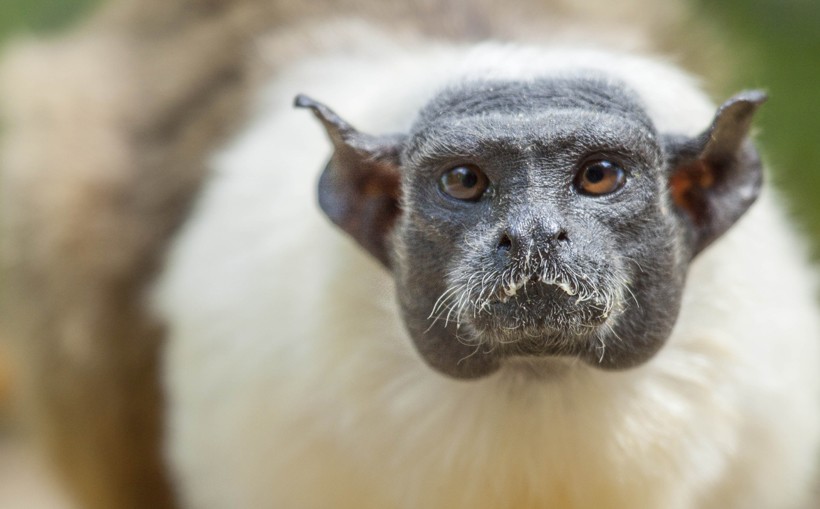
The pied tamarin is an endangered species
?
Image credits: Berendje Photography/Shutterstock
The Brazilian Government has initiated an environmental education program for the conservation of the pied tamarin, during the 1980s. As part of the population management program, captive breeding of the animal has been implemented at few institutions like the Rio de Janeiro Primate Centre (CPRJ) and Universität Bielefeld, Germany. All individuals derived from such centers have been registered as the property of the Government of Brazil.
Evolutionary history
Tamarins belong to the Family Callitrichidae, Order Primates under the Class Mammalia of the Phylum Chordata. This group comprises new world monkeys who originated from an indistinct location south of Amazon and west of the Rio de Madeira. The new world monkeys, still only found in Central and South America today, divided and moved west and northeast and hence evolved into two clades around 10 million years ago. Later on, the north-eastward clade moved further westwards with the consequence that both populations overlapped. The new world monkey comprises the five families Callitrichidae, Aotidae, Pitheciidae, Cebidae and Atelidaethat. All families are classified under the superfamily Ceboidea, a family that is known for their peculiar flat-nose with sideways nostril-openings.
Their closest relatives are old world monkeys and apes that have downward nostrils. Ceboideans have evolved from the old world African monkey around 40 million years ago. It has been hypothesized that the ancestral infra-order Simiiformes split into two parvorders, Platyrrhini, the New World monkeys today in South and Central America and parts of Mexico, and Catarrhini, comprising Old World monkeys and the apes in Africa. Individuals of the Platyrrhini group are believed to be migrated to South America. The route of migration has been proposed as a series of islands across the Atlantic Ocean existing at that time.
Funfacts
- Pied tamarins are listed as endangered (IUCN) and is considered among the most endangered primates of the Amazon belt.
- Pied tamarins belong to the new world monkeys, monkeys with a peculiar flat-nose with sideways nostril-openings.
- Their common mating system, which is polyandrous, is very rare. With polyandry only the single alpha female mates with multiple males.
- The ovulation of other females within the group get suppressed by pheromones secreted by the alpha female.
- Pied tamarins live in a social family-like bond where adults share the parenting of the infants.
